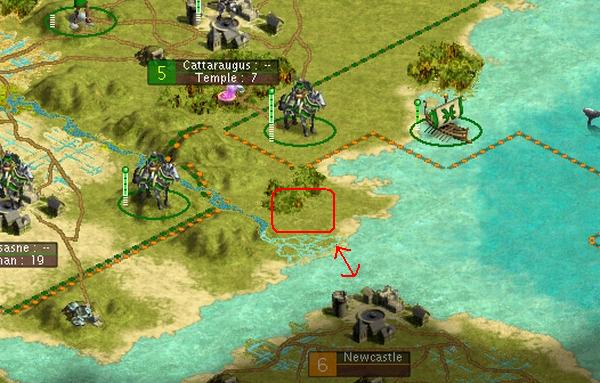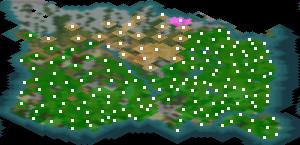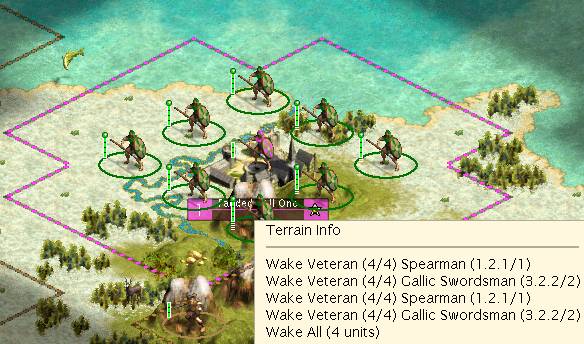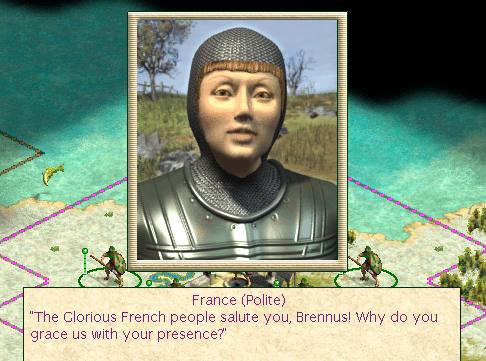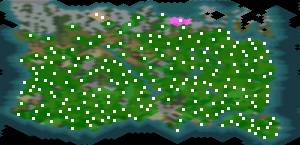I'm late joining the spoilers this month because I didn't meet the conditions for spoiler1 until now, at a time when my game is far along. So I'm posting my full story to date on this thread.
I'll start my story in the middle, with a picture. The date is 680AD and my world looks like this:
Although I don't have conquest at this date, I easily could have. Instead I have something I want more - that single pink town in the northern tundra. Zooming in on it reveals this:
It is a small village of Gauls, who delusionally think they are holding out against the invader

And here's the best part, what their hapless leader Joanofarctix thinks of me:
Poor Joanofarctix. Obviously she has no idea whose fault it is that she'll be shivering her buns off for the rest of the game.
So how did the world get to this happy state? For that story we must turn the clock back to a time slightly before 4000BC.
Pre-game:
Before starting I planned to:
1) Go for a multi victory milked game with a diplomatic win included. To do this I'd have to avoid taking many permanent AI attitude hits. (These are now fairly well understood thanks to Bamspeedy's excellent article in the Strategy section.) I planned to:
a) Break no deals.
b) Raze no cities, not when asked and not by auto-razing.
c) Declare war a minimal number of times.
d) Pick one Civ who would be my "friend" and get that Civ down to one city without fighting them.
2) Use Gallic Swordsmen to the max. So I'd:
a) Slow research as much as possible.
b) Use warrior upgrades heavily as well as building GS's.
Opening moves:
I started by moving the worker NE to the hill. That didn't reveal any reason to move the settler so I founded Entremont at the start position.
I set research to zero. (And left it there until 490AD

)
Initial production in Entremont was warrior, warrior, warrior. The first warrior explored west, the second south, the third north and then west when he reached a pair of volcanoes.
After the three warriors Entremont produced a settler and then a granary. By the time I wanted the granary I was able to buy Pottery fairly cheaply. I built the first settler before the granary because of the nearby NW fish, reasoning that I'd gain more total food by settling them first.
My second and third towns were placed across the NW lake from each other to share the fish. Both of these towns built a granary, and then each of them grew every four turns. (They alternated using the fish 2 turns out of 4 to get this result.)
Early development:
For a long time my second and third town (sharing the NW fish) produced settlers and workers. Entremont also produced a few settlers. Other towns produced barracks and warriors.
I left a few early towns unconnected. These constantly built warriors until late in my conquest phase, an ongoing source of units to be upgraded to GS.
My exploring warriors met a number of Civs quickly. I traded for Alphabet early on. Then when Writing became available (1710BC) I traded to get Writing, contact with all Civs, all tech to that date, and everyone's gold.
In 1175BC some of my rivals learned Map Making. I traded maps to get all tech known to that date plus all maps and gold. At this point I had everything I needed for the coming wars except a decent military. I started working on that. I also began fomenting distant wars, trading to get alliances against China and Egypt.
Status at 1000BC:
12 towns
6 barracks, 3 granaries, 1 temple
16 warriors
3 native workers
7 foreign workers
629g in the treasury
happily behind in tech of course
 Beginning conquest:
Beginning conquest:
By 650BC I felt that I had enough strength to begin war. I decided not to wait for an advanced government. It would take too long before they were known, time which the other Civs would use to gain strength. I'd start immediately, taking my GA in Despotism.
I chose Greece as my first target because:
1) Greece was the only scientific Civ in the world. She was a strong researcher and needed to be slowed down. And more important, if I could eliminate her before she entered the Middle Ages that would eliminate a free advance from the world.
2) She and Rome were my two most logical targets geographically.
3) Hoplites. These were bound to be some of the toughest defenders I'd encounter. The sooner I hit them the less Hoplites I'd run into, and they wouldn't have a city bonus yet.
I had 16 veteran Gallic Swordsmen at this date. I declared war on Greece and began. I'd bought an alliance with Greece against China much earlier, so Greece's forces had been diverted. I only suffered a few casualties in taking her four core towns. That left her with four scattered small ones. It would take too long for my forces to weed those out so I gave her peace for two towns and some tech and then attacked Rome.
My troops went through Rome easily. She hadn't connected iron yet. Finishing Rome off proved difficult though and formed a pattern I followed with all subsequent Civs. The problem was, I'd take a Civ's core cities and then be left facing a handful of scattered size one towns. If going just for conquest I could have made peace in exchange for some of those towns, then broken peace, razed what towns were left, and moved on to the next Civ. But I needed to avoid the attitude hits from that. So when I had each Civ reduced to a handful of size one towns, I positioned troops near the remaining towns, then took each when it either grew to size two or gained some culture. When my forces grew larger during later wars I'd divide them, leaving some behind to do this cleanup while the rest advanced, but it still slowed things down.
Continued conquest:
The Golden Age was highly productive even in Depotism. I built a good number of Gallic Swordsmen and upgraded nearly one warrior per turn. When it was over in 230BC I had about 40 Gallic Swordsmen. I'd lost about a dozen up to that point.
Around the middle of the war on Rome I got my first Great Leader. He built the Pyramids. At the end of the war on Rome I got a second one. He built Forbidden Palace in Veii.
Next I attacked the Iroquois. Early in that war my peace deal with Greece expired and I attacked her again, taking her out while she was still one tech short of finishing Ancient Times. (Phew!)
The Iroquois had built the Great Library. Capturing it was a bonus but I stayed in Despotism anyway even when it gave me new governments - I wanted to rush temples in captured towns.
At 10AD I'd just finished the Iroquois and started on China. After China I took Egypt, then split my growing forces to attack Japan and England at the same time. During my assault on Japan the Aztecs declared war on me, causing a further split in my forces and some hasty reorganization.
I had a few more leaders during all these wars. One went to Sun Tzu's. A couple of others went to armies - GS armies are helpful in attacking strongly defended towns.
I flipped to Monarchy late during these wars when it seemed likely to be more useful overall. I also started researching aggressively near the end of the wars, when I no longer wanted to devote all money to warrior upgrades.
At the end of all these wars Carthage and France were my only remaining rivals.
Forming a lasting friendship:
Early in the wars I chose France to become my friend, the Civ I could count on for a vote at the end

I picked France because she was weakest at the time and had an ongoing war with the Aztecs.
Long before I actually fought her I declared war on Japan. I then got an alliance against Japan from France, so that two Civs would be attacking her. I also diverted some production to send a settler with 9 spearmen and 5 GS's to the northern wasteland. The settler founded a town, the support units surrounded it, then I gave it to France. This would be a safe haven for France when her other towns were gone.
After some time France's enemies all made peace and she still had six towns, plus the one I'd given her. Drastic measures were required. I declared war on France and allied with Aztecs and Carthage against her. I didn't actively participate in these wars on France of course!

When the Aztecs declared war on me they gave France peace. From that time on I did all I could to keep Carthage happy with me and renewed our alliance against France when necessary.
Eventually Carthage took the last French city just as I was finishing off the other remaining Civs. Yay! Soon after that the situation was as shown in the minimap at the start of this note.
Completing conquest:
Due to the above strategies Carthage was rather strong when I declared war on her in 680AD. I anticipated lots of Numidian Mercenaries, fortified in towns and cities, with some of those on hills. But I had 106 Gallic Swordsmen and ongoing production was running at perhaps 5 GS/turn. So I decided no finesse was necessary, a couple of GS SOD's could just march through. And so they did. Carthage learned Chivalry during this war but, since I'd cut off her iron sources early in the war to stop Swordsman production, I never saw a single Knight in the entire game.
In 840AD Carthage was down to a single tundra town and I gave her peace. Two turns later I gave her a second town (to make her my rival in the UN vote at the end) and the world looked like this:
The greening of the world:
All that lovely green on the minimap kept reminding me of something and I finally realized what - grass! And hey, (or is that hay?) I know what grass is good for - cows! Lots and lots of cows. Time to get into dairy farm mode. I'm now just started on that phase and have just revealed the barbarian lands.
The tech pace:
I did a number of things to attempt to slow tech:
1) I didn't do any research. If you want a very slow tech pace, don't learn anything new - learning something makes it cheaper for the other Civs to also learn it.
2) I kept tech trading to a minimum. I only traded techs (in either direction) when I saw a clear immediate value in what I got from the trade.
3) I traded a minimum of contacts, just enough to get what I wanted. The longer early contacts are delayed, the more expensive early research is for the other Civs.
4) I traded for a number of early alliances to foment wars. The more the other Civs are warring, the less they can research.
5) In the critical map trading turn, after I got everything I could from trades, I gave away maps to all Civs I hadn't already traded them to. The AIs value maps highly. If I'd left some Civs with map knowledge that others didn't have, they'd have traded it for tech. So I devalued everyone's maps by giving them away.
6) I took Greece out before she reached the Middle Ages.
Miscellaneous notes:
Gallic Swordsman: In the pregame thread I said that I thought the Gallic Swordsman was overpriced. I've changed my mind. This UU is absolutely awesome on the right map. And this is the right map. For me it helped to think of them as weak Knights. (Vs. as fast Swordsmen.) They can be used the same way as Knights, attacking from a distance and moving rapidly from one defensive cover to the next, tactics which increase the already good survivability afforded by their retreat roll. The ability to create them for just 80g from warriors is great - weak border towns can pump warriors easily enough. Of course I lost a heck of a lot of them, but I found that I could easily produce new ones faster than I was losing them.
I do think that the standard PTW upgrade path for these units (to Medieval Infantry) is plain silly. I would not trade a 3-attack 2-move unit for a 4-attack 1-move even if I got gold back in the bargain. If the map had used the standard upgrade path I think I'd have scuttled my Great Library before learning Feudalism. Later I'd have taken Feudalism and Monotheism from someone when both were available, hurried to learn Chivalry, then finished the game with some Knights mixed into my forces. As things were I could have done that anyway, without scuttling the Great Library. And it might have been a smarter way to finish. But I couldn't resist finishing with Gallic Swordsmen, just as I'd started 1400 years earlier - the chance to do that was just too sweet.
Topology: In the pregame thread I ventured a guess that we might get a donut shaped land mass. That turned out to be not a bad guess. The long central lake gave that effect. My progress through the other Civs could be viewed as consuming the donut in a clockwise direction from the starting point.

Goody huts: I popped 25g, barbarians twice, and then in 670BC Literature from a hut in the far NW.
Barbarians: Aside from the popped ones I encountered few barbarians until after controlling the world. Occasionally one drifted south through the volcanoes and I'd dispatch him, but that was it. I remembered a lesson from GOTM16 - go for the bird in the hand, don't worry about special areas until other priorities have been handled. So early on when I saw the strong volcanoes in the north, I ignored them and explored elsewhere. And after that I had my hands so full that I never did explore them until after taking Carthage. I guess I also kept the other Civs so busy that they didn't hit the volcanoes. When I finally went there I found that just one volcano remained on the spot where my warrior had seen two, so I guess an AI did attack them at one point without breaking through. I've only entered the barbarian lands now, around the tech cutoff for this spoiler. There are a few hundred barbarians up there and their camps. It will take some time to clean them out.
I have a theory about the "restless" barbarian activity on this map: I wonder if the map is indeed set at restless, but there's a limit on the number of barb camps in the world? And that with so many camps up north in one cluster, no new camps can pop up elsewhere until those are eliminated?
 @ Zagnut
@ Zagnut I'm building a couple knights and hope to get a foothold soon.
I'm building a couple knights and hope to get a foothold soon.
 I've only built 1 spearman and 1 pikeman all game so far.
I've only built 1 spearman and 1 pikeman all game so far. 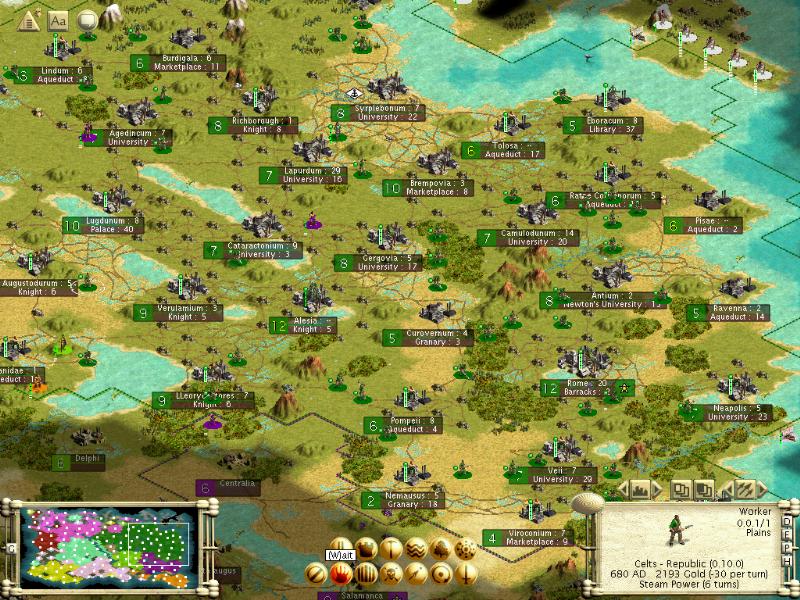
 Overall, it takes at least 45 minutes for each turn. Since this game has become very time consuming, this will be my last milk. I really want to say that this will be my last GOTM, but I'm afraid I won't be strong enough to fight my Civ addiction.
Overall, it takes at least 45 minutes for each turn. Since this game has become very time consuming, this will be my last milk. I really want to say that this will be my last GOTM, but I'm afraid I won't be strong enough to fight my Civ addiction.